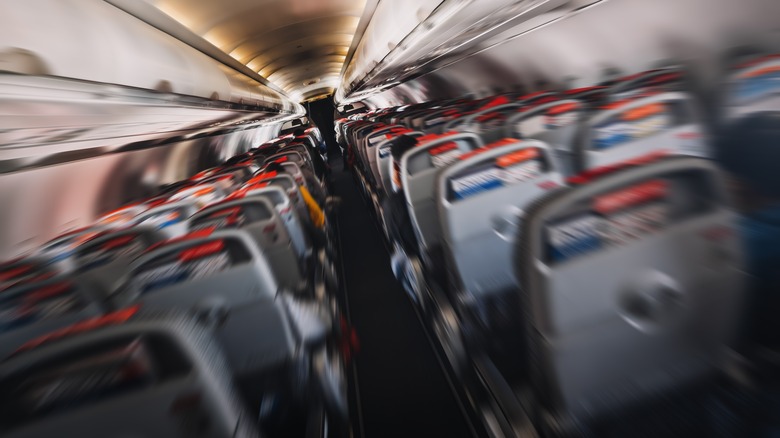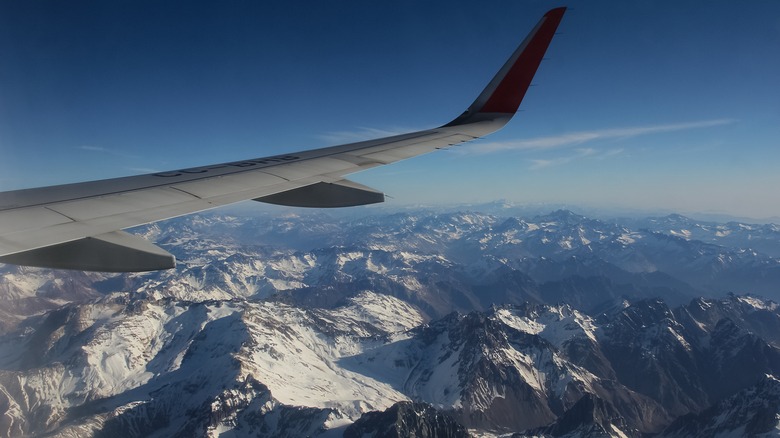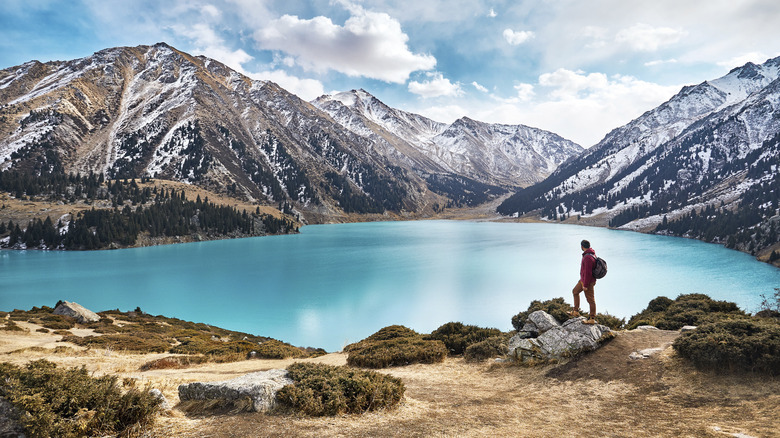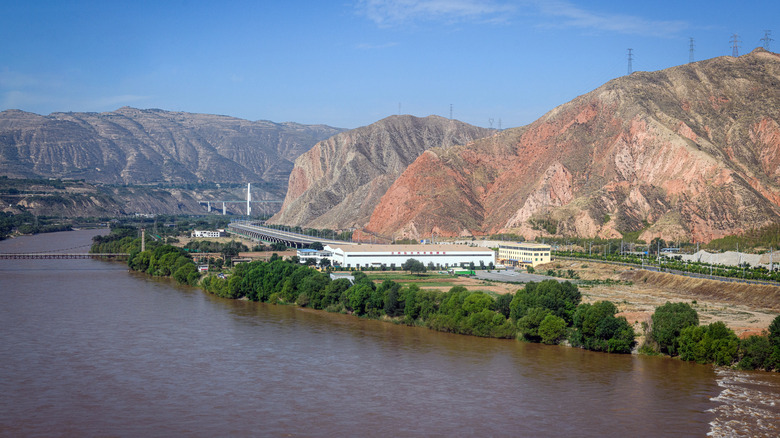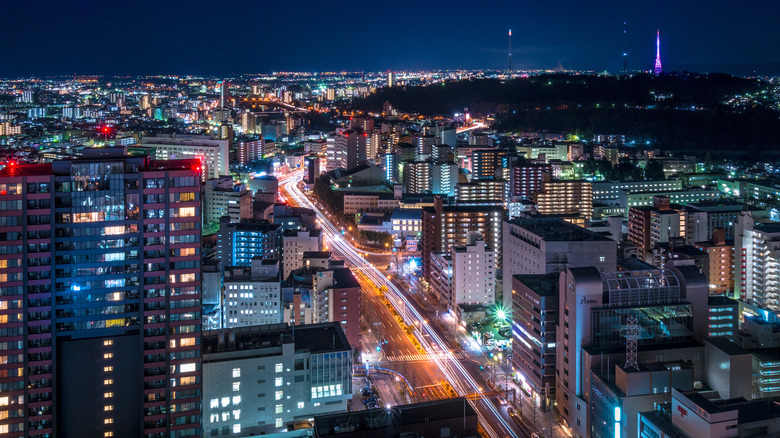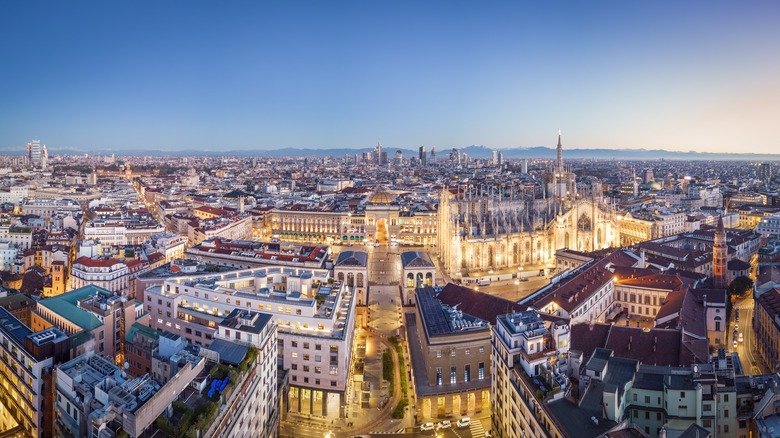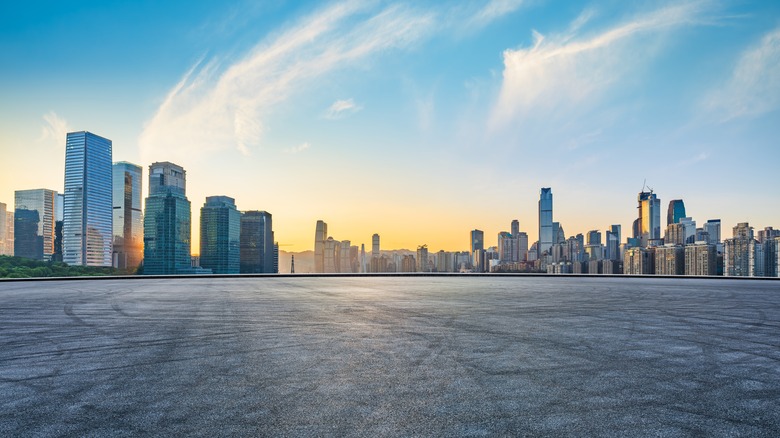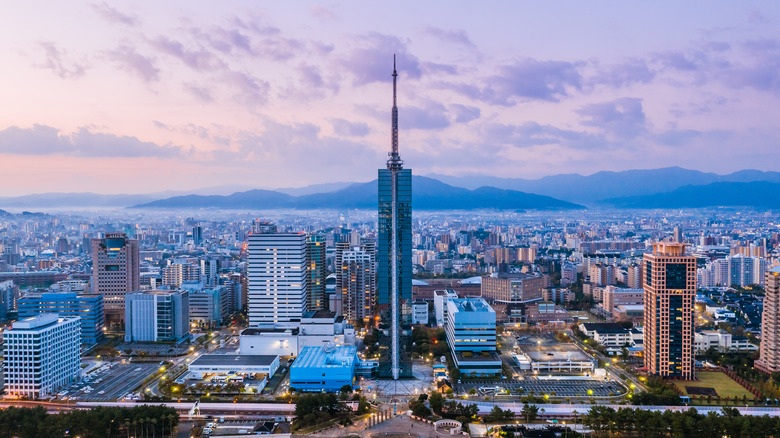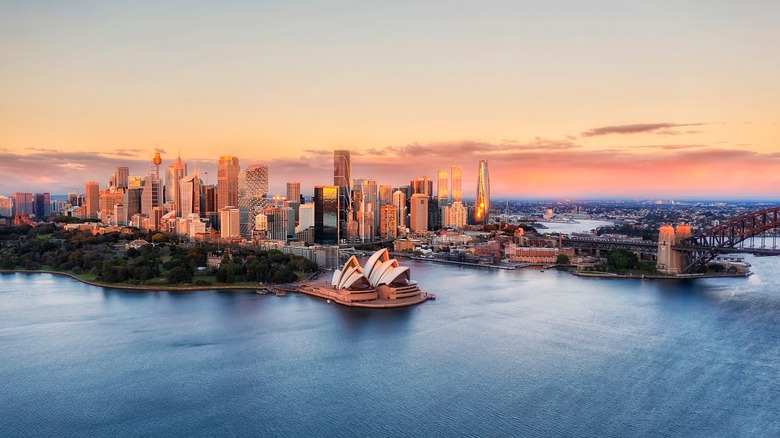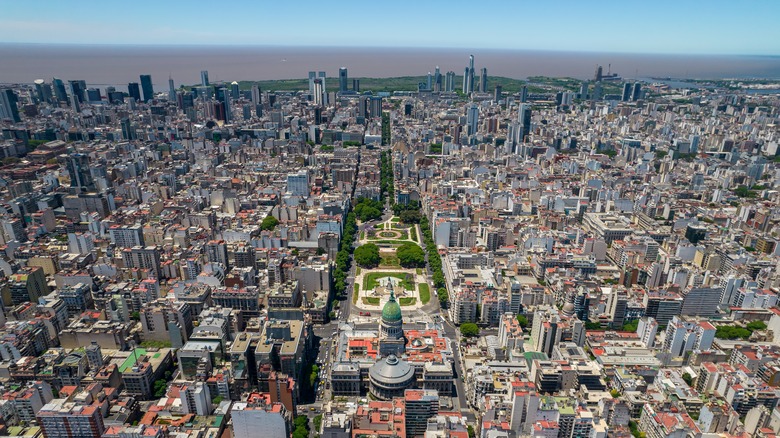These Flight Routes Experience The Worst Turbulence In The World
No matter how perfect the vacation spot is, no matter how much time you spend pouring over the minutia of the trip and building in contingencies, there is always one nagging complication that has to be faced. You have to get there.
Flights bookend a large proportion of such journeys, and it's a simple truth that while it remains one of the safest ways to travel, some routes throw more curve balls at you than others. In some cases, this comes down to the time spent in the air; New York to Singapore takes an eye-watering 18 hours and 40 minutes to complete. For others, it's about the smoothness of the voyage itself. Severe turbulence can, after all, rattle even the most seasoned of travelers.
According to Ignacio Gallego-Marcos, creator of the site Turbli, the amount of turbulence you experience on any given flight is — at least to some extent — predictable. Turbulence is created when a stream of air traveling at high speed crosses paths, with one moving more slowly. According to Gallego-Marcos, this tends to happen at certain locations: Jet stream boundaries, flying over mountains, and hurtling through thunderstorms. Thankfully, pilots are able to divert around thunderstorms and tend to avoid crossing jet stream boundaries whenever possible. Unfortunately, things are not so simple when it comes to mountains. Flying over such ranges is a function of the route taken.
Turbli's forecasting service provides some peace of mind when it comes to planning your trip, and its database offers insight into the most turbulent routes out there. In some cases, it's a specific line on a map, such as the trip between Almaty and Bishkek, the Capital of Kyrgyzstan. In others, there are repeat offenders: Both Sendai and Santiago airports promise bumpy rides in multiple directions. According to Turbli's historical data, here are the most turbulent flights in the world.
Santiago - Santa Cruz
The largest city in — and capital of — Chile is home to close to seven million people. Famed for its colonial architecture and wine and as well as a stepping stone to the relatively nearby Easter Island, Santiago is also the hometown of one of Chile's great literary heroes, the poet Pablo Neruda.
Visitors flying into the city are treated to stunning views of the snow-capped Andes. Noted as the most extensive mountain range in the world — it is almost four and a half thousand miles end-to-end — they are home to active volcanoes and vast salt flats and are even responsible for the weather phenomenon known as El Niño. Unfortunately, they are also the location of some of the worst turbulence you will find on any flight path anywhere in the world.
Turbulence is measured using a scale known as the Eddy Dissipation Rate, hereafter referred to as the EDR. It ranges from 1 to 100; anything below 20 represents smooth flying conditions, and anything above 80 is considered extreme. Indeed, most planes would be impossible to control in such situations. Sandwiched in between these two deltas, you will find moderate (20-40) difficulty walking, strong (40-60) powerful strains against the seat belt, and severe (60-80), which Turbli defines as "Violent and sudden changes in altitude."
Santiago's 2023 EDR score of 17.568 might appear as a sign of plain sailing, but the contrary is true. It represents an average level of disruption over the entire journey. And since the flying time between the two cities is 3 hours and 7 minutes, portions of the flight over the high plateau of the Andes can get very rough indeed.
Almaty - Bishkek
While it is true that the 50-minute flight from Almaty — Kazakhstan's largest city — and Bishkek, the capital of Kyrgyzstan, is not high up on people's bucket list, there is much to recommend in the region. Kyrgyzstan is a land filled with mountains, valleys, and national parks, and Bishkek is a city of bustling markets, temples, and incredible architecture. It also just so happens to be one of the cheapest countries to explore in all of Asia.
The city borders the glacier-rich Tian Shan range of mountains, which rise at their highest point, some 24,400 feet high. Translating loosely as the Mountains of god or celestial mountains, they stretch some 1500 miles from west-southwest to east-northeast, skirting the border between China and Kyrgyzstan.
While the mountains make for a breathtaking vista, they do present some problems when making the short trip from Bishkek to the east. Flights run adjacent to and then cross the range, and while the picturesque alpine lake Issyk Kul is visible from the air, the ride is far from a smooth one. Turbli gave it an EDR rating of 17.457, meaning that the 130-mile jaunt is sure to be a bumpy one.
Lanzhou - Chengdu
Lanzhou's EDR score of 16.75 marks this flight into Chengdu as something of a rough ride, but the 410-mile trip is still worth the white-knuckle moments it creates. The capital of China's Northwest Gansu province, Lanzhou, has been part of the Silk Road since the days of antiquity; Chengdu lies some way to the south in the Sichuan province. Interposed between these two points, the Longmen Mountains form an imposing barrier.
Still, Chengdu has as much to offer as Lanzhou itself. Where the former is noted for its historical grottos, White Pagoda Mountain, and cruises up and down the Yellow River, Chengdu's reputation is one of fine cuisine. Some of the best spicy chili sauces are found in the Sichuan region, and the capital's specialty dish — the appropriately named Bang Bang Chicken — competes for attention with the Chengdu Hot Pot. This spicy, meaty dish comes in many varieties.
The mountains are, of course, to blame for the comparatively bumpy glide inward, but it's important to note that the flight time over them makes only a small part of the journey itself. As with other routes on this list, turbulence is sometimes distressing but rarely dangerous; an interrupted meal service is about the extent of the inconvenience on most flights, and for short-haul flights such as this — it only takes around an hour and a half — that's something of a non-issue.
Centrair - Sendai
Centrair Airport is built upon an artificial island in Ise Bay, close to the city of Tokoname, which has been a center of pottery production in Japan since the 8th century. Descending from 30,000 feet towards a floating island is always a little hair-raising for those unfamiliar with the process, but it's not the landing that puts this route so high up on the list. Turbli gave the route a 16.579.
The guilty party here is Sendai, or rather the path jets take to get there. Japan is notoriously mountainous, and the most direct line between the two cities in question places many prominent peaks directly within the flight path. Areas of high elevation around the Nagano Prefecture create the perfect conditions for turbulence during the middle section of the flight. Flying to Sendai from the cultural hub of Osaka — which is incidentally a great place to visit if the Tokyo crowds are a little too much for you — suffers from the same issue. However, the slightly longer flying time dilutes the EDR score down to a still-impressive 16.307.
Still, this is a well-trodden route, and pilots are well used to how air currents behave. Turbulence in this region is all part of the ordinary course of travel here, and with a flight time of just over an hour, you'll soon arrive at your destination a little worse for the wear.
Milan - Geneva
When people's minds turn to Milan, images of history, fashion, art, and fine cuisine flash before their eyes. It's an ancient city and well worth a visit, but getting in and out of the city by air is, at times, at least somewhat problematic.
Milan traces its origins to Celtic tribes who settled the region back in 400 BCE. It's one of the most walkable cities in the world, and there's something to see and do around every corner. 12th-century Romanesque churches rub shoulders with even more ancient Roman ruins, parks are ubiquitous, and then there is the city's magnificent art deco-infused central station, a masterpiece of design that has to be seen to be believed.
Geneva's reputation is less dynamic. A financial center and diplomatic hub, the city was chosen as the site of the ill-fated League of Nations — humanity's first attempt at an organization dedicated to world peace and international cooperation. Today, it is a place of breathtaking scenery, fine chocolate, science, and, in the winter, of course, skiing.
By air, the two cities are only 155 miles apart, although the driven route is closer to 200. The drive is easy in summer, spring, and fall, with toll roads and tunnels making up the bulk of the journey, but roads become difficult to navigate during winter months. Flight time is less than an hour, but one inextricable truth remains when it comes to the flight path: the Alps are in the way.
As we've seen from other locations, mountain ranges generate the perfect conditions for some less-than-smooth sailing, and the Alps are no exception. Crossing the Alps from southern locations such as Nice or Marseille is turbulence-filled, as are flights from Milan to other northern locations such as Zurich.
The Milan to Geneva route, however, remains the worst of the worst. Its EDR score of 16.398 puts it only slightly behind the Sendai short-haul, and while the time spent in the air is brief, it's still a good idea to know that you are in for a bumpy ride ahead of the flight so you don't panic when things get a little shaky.
Xianyang - Chongqing
This route — the second Chinese entry on this list — takes passengers along a diagonal line from the Northeast to Chongqing. This city was a part of the Sichuan province until 1997 when it became a direct-controlled municipality. The direction of travel means that it avoids a direct flight over the Longman Mountains, cutting out the turbulence that makes a southerly approach to Chengdu so vexatious. Alas, it still manages to rank highly on the EDR scale with its score of 16.041, making it the eighth most turbulent flight in all of Asia.
The reason for the disturbance is down to the mountainous terrain below. Much of the journey takes you over the Shanxi province — another Silk Road alumni. While this region of China lacks the high peaks of the Longmans, the terrain is more uniformly mountainous, especially in the south. Flying over the region produces fewer peaks of turbulence, but the choppy air is more consistent.
Not that a few shakes and belly flips should dissuade you from traveling there. The area surrounding the city is breathtaking and can be enjoyed as part of a cruise down the Yangtze River or explored on foot as part of a hiking tour. The municipality itself offers a wealth of cultural heritage to choose from, including a trip to see the UNESCO World-Heritage Dazu rock carvings, the unique architecture of the Ciqikou old town, as well as a delve into the region's spicier culinary delights, a holdover from its days as a Sichuan heritage.
Osaka - Fukuoka
Japan makes a return to this list with another rough ride, this time between the budget-friendly port city of Osaka – situated at the Northern tip of the Kii peninsular — and Fukuoka, which lies on Japan's southerly Kyushu Island. Isa Bay lines the East side of the peninsular, Osaka Bay the West, and as a consequence, flights from Osaka going to Sendai and beyond suffer the same fate as those leaving from Centrair. Indeed, the Osaka Sendai route maintains an EDR score of 16.307 making it only slightly less turbulent than the trip from Centrair.
The trip to Fukuoka, however, is heading in the opposite direction with a flight distance of 282 miles, much of which is over the water. Even so, its EDR sits at 15.974, indicating that at least some parts of the journey face significant turbulence. Its path does take it over Awaji island — an area known for its low, mountainous terrain — but time spent over the area is brief. The next leg, however, takes passengers over Kagawa prefect, an area known for its high conical peaks and low plateaus. Lastly, there is Fukuoka itself, after some time spent flying over water.
Surrounded on three sides by mountains and sitting on the southern coast of Hakata Bay, it is the sixth largest city in Japan and is well known for its Hakata Ningyo — unglazed clay dolls produced in the region since the 1600s. A confluence of events makes this trip less smooth than it could be. Turbulence is concentrated over the journey's mountainous sections, leaving time spent traveling over water a relatively benign experience.
Brisbane - Sydney
Australia isn't a place you might usually associate with turbulence. For most visitors, getting there involves a long flight over an ocean, and as we have seen, bumpy rides tend to take place over mountains. Which is not to say that colliding currents of air don't happen over water — they most assuredly do — it is more that such areas are both a known quantity and, as such, eminently avoidable.
To be clear, Australia is a flat country — the flattest continent in the world, in fact, with an average elevation of slightly less than 1000 feet. Australia offers some of the best beaches in the world and notoriously friendly locals and is definitely one for the bucket list. It also comprises some three million square miles and takes over four hours to cross by air from east to west.
The flight between Brisbane and Sydney is much shorter than that; it's a straight line of 467 nautical miles and has a flight time of just over an hour and a half. Unfortunately for those hoping to get a little shut-eye, the flight path takes you over the one location in Australia that really bucks the low elevation trend: the Great Dividing Ridge.
This 2300-mile stretch of plateaus and mountains dominates the entire eastern side of Australia, running along the coasts of Queensland, New South Wales, and Victoria. Further south, the highlands rarely venture above 3000 feet, although an area close to the New South Wales and Victoria border — known locally as the Australian Alps — contains the continent's highest peak — Mount Kosciuszko.
Still, flying from Brisbane in the North East takes you over the inland parts of the Gold Coast, and the rocky terrain below definitely creates some turbulence. The route's EDR score of 15.31 makes it the bumpiest leg in all of Australia, although, in truth, most flights from Brisbane heading to more westerly locales such as Melbourne, Canberra, or Adelaide can also get a little dicey at times.
Buenos Aires - Florianopolis
Buenos Aires, the capital city of Argentina, is notable for many things. Known colloquially as the Europe of South America, visitors are treated to stunning architecture in both the Neoclassical and Italian Renaissance styles, phenomenal — and Tango-laden — nightlife, and a superb culinary presence. It's also flat — very, very flat.
Florianopolis lies to the north of Brazil and is a hub of surfing, seafood, an all-around party atmosphere, and an LGBTQ+-friendly hotspot. The flight between the two destinations is only around two hours but — as you'd expect from a highlighted route — it takes you over some mountainous terrain.
Traveling over the similarly flat plane of Uruguay is generally uneventful, but the approach to Florianopolis is different. The Pico de Monte Negro sits to the southwest of the city and is close to 5000 feet in elevation, and other peaks — including Mora Boa Vista, the highest mountain in Santa Maria — lie close to the flight path.
It all results in a choppy end to your journey with an EDR rate of 15.076. It doesn't end there, though, since flying out of Florianopolis in other directions can also get a little rough due to the local topography. Indeed, flying to Santiago from this location takes the score up to 15.307, as the unique topography of each location lends a little synergy to the proceedings.
How we rated the routes
As stated earlier, we relied heavily on Turbli's excellent year-by-year database to compile this list. Repeat offenders were mentioned but not ranked here; certain locations, such as the flight into Sendai or multiple routes in and out of Xianyang, are often represented in most-turbulent lists.
Where possible, personal experience was used to confirm the relative discomfort of specific routes. I am, for example, very familiar with flights into Sendai and paths across the Great Dividing Range. Having crossed the Andes a number of times — although not on the specific route mentioned here — I can confirm that it gets a little choppy.
